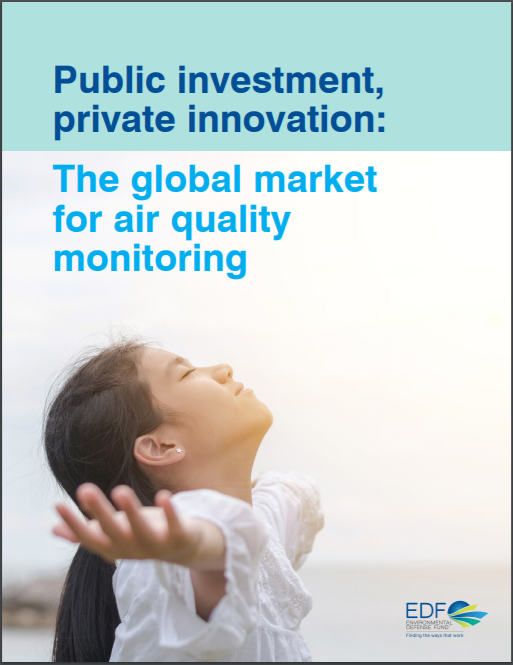- Resources
- Public investment, private innovation: The global market for air quality monitoring
Resources
Public investment, private innovation: The global market for air quality monitoring
Published: October 1, 2020 by EDF Staff
Entrepreneurs and technology innovators can play a role in solving air pollution challenges across the globe by investing in the growing market for sensor technologies.
The need to clean the air we breathe has never been more clear. Public pressure to better understand air pollution and health impacts is mounting, at the same time that cities are grappling with how they can implement and scale solutions to improve air quality.
Technology innovators can help governments develop air quality monitoring networks and air quality policies that respond to unique national, regional and local concerns. But before doing so, it’s critical that technology providers become familiar with the particular policy and technical contexts for the areas where they work, or are planning to expand into, as well as where the funding opportunities exist.
Public investment, private innovation: The global market for air quality monitoring provides a landscape of regional demand drivers, public funding opportunities and policies for air quality monitoring to guide technology providers as they explore and invest in new markets. The report focuses on five regions: the United States and Canada, the European Union, Latin America, India, and China.
Key findings and takeaways for technology providers
While approaches to air quality mitigation and monitoring are varied and specific to regional policies and concerns, the following key findings emerge as trends across the five regions in this analysis.
1. National air quality standards drive air quality monitoring programs and investments in regulatory-grade equipment. Technology providers can look to pollution standards to indicate where governments might be expanding their monitoring efforts.

2. Regional and local agencies are the primary funders and implementers of air quality monitoring networks. While ambient air quality standards are set at the national level, regional and local agencies are primarily responsible for funding and implementing regulatory-grade monitoring with support from national government agencies and international investors.
3. Monitoring is undertaken for “beyond compliance” purposes. A growing number of cities and local jurisdictions across the globe are monitoring air pollution at the hyper-local level, at times through regionally and locally funded pilot initiatives that use lower cost sensor networks as education and communication tools, and to inform air pollution mitigation actions.
4. Public demand for lower-cost sensors has increased significantly in the past decade and is expected to continue to increase as a result of pressure from environmental advocates and the public’s desire to better understand personal exposure to air pollutants and toxics.
5. Agencies view lower-cost sensors as complementary to regulatory-grade monitoring. Since regulators and researchers remain skeptical of data produced by lower-cost sensors, government agencies and academic institutions are evaluating how lower-cost sensors can complement existing networks.
6. As countries, regions and cities expand their air pollution monitoring networks, the need for data validation and analysis will also grow, especially due to regional and local governments’ lack of capacity. There is an opportunity for technology providers to support government agencies in drawing informative insights from the data generated from these monitors, as well as to improve reference monitoring sites.
7. Effective communication of air quality data is a critical component of air quality management systems. Technology providers can fill the communications gaps by providing services that ensure real-time data is accurate and placed into an appropriate context – especially as public interest in how pollution monitoring data can be interpreted for health outcomes increases.
8. Multilateral agencies are important sources of funding for beginning air quality monitoring efforts in locales where none exists and for building capacity for nascent efforts. Funders, such as the World Bank and the United Nations Development Programme, are investing in better monitoring and management capacities. In countries where monitoring efforts are either in the early stages or scaling up, public spending on air quality monitoring consists of regulatory-grade monitoring equipment.
9. Air pollution is not yet a priority government issue in some countries. Some programs are underfunded and understaffed — with growth opportunities in the areas of quality assurance and quality control. In many cities, conventional air monitoring is defective or non-existent, particularly in developing countries. This limits the availability of reference air quality data at a local scale, which might delay deployment of lower-cost sensors.
Regional findings at a glance
United States & Canada
- Federal agencies provide key funding support for air quality monitoring networks, but subnational entities provide a higher portion of overall costs to operate and maintain equipment.
- Funding for air quality monitoring at federal levels has been consistent over the past 10 years.
European Union

- Across the EU, air quality is a priority environmental issue, and funding air quality monitoring is considered a key component of air pollution mitigation.
- The EU has innovative funding methods for advancing new air quality monitoring technologies and analysis.
Latin America
- High concentrations of urban populations present opportunities for emerging technologies.
- Multilateral organizations provide critical support for national government agencies to establish ground-level and regulatory-grade monitors.
India
- National targets are driving the expansion of the national ambient air quality monitoring network and investments in alternative monitoring technologies, such as lower-cost sensors.
- Technology providers can support equipment calibration and data analysis.
China
- China’s “battle for blue skies” plan has resulted in significant investments in air quality monitoring.
- Air quality monitoring is limited in certain regions — alternative monitoring technologies are helping to fill the gap.

